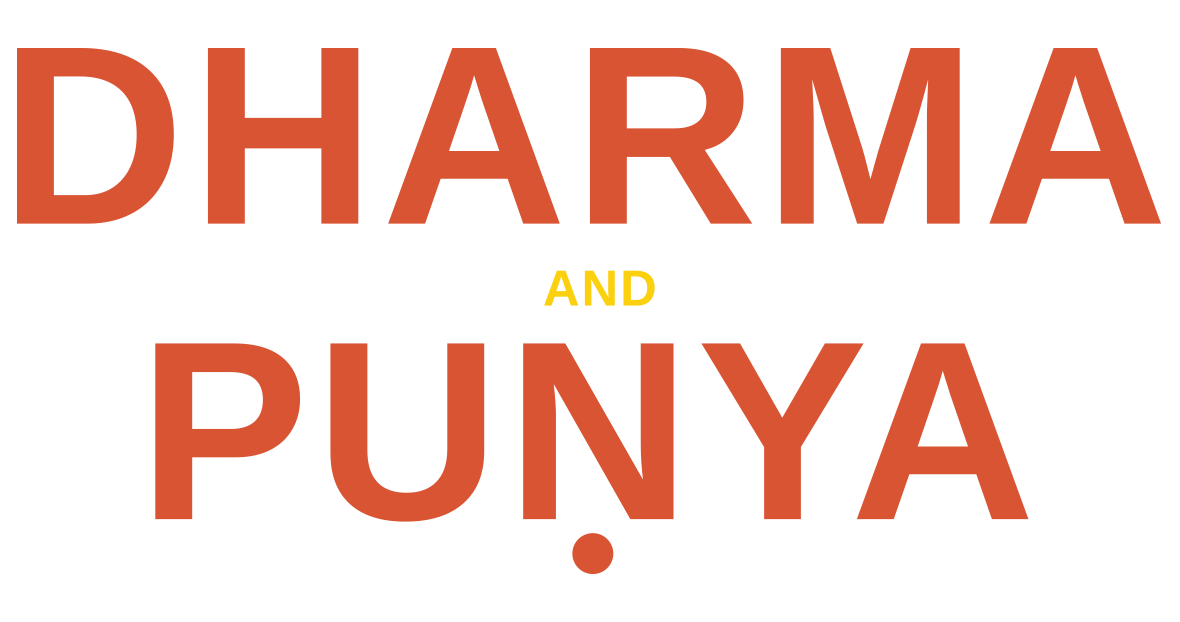Sukundā

Typical Use
Oil wick lamp featuring Ganesh or (more rarely) other major deities; first to be lit in offering and used to light incense and other lamps during ritual process.
Thāpin

Typical Use
A brass container for thon (rice beer); used in auspicious occassions, like i.e., rituals, birthday celebration, Mha Pūjā (New Year Celebration for worshipping the self) etc.
Pathi

Typical Use
A vessel used for measuring grains, but is also used on some auspicious occasions for rituals of welcome called las khus.
Kollā

Typical Use
A copper dish used to offer a Pinda dāna, including a full course meal, to the deceased person/ancestor by a son/daughter or a close relative with a special pūjā, a ritual.
Argha

Typical Use
A copper teardrop-shaped bowl used with the kollā to hold piṇḍa dāna offerings made to the dead: water, cow milk, buffalo milk, yogurt ghee+honey, liquor.
Mākacā

Typical Use
A clay monkey figure used to make black soot; a wick placed on the mākacā with a small clay bowl inverted above it collects black soot. This makes black moni tika that is applied to the top of the forehead.
Maṇḍa

Typical Use
Used by the priests during the pūjā; can be used by householders for their daily ritual.
Kota

Typical Use
A brass dish to hold the ingredients for complex pūjā.
Kota sumali

Typical Use
This is a set with Kota to hold extra ingredients, like goja, extra flowers, etc.
Sinha: Mu (a)

Typical Use
A set of containers to hold orange and yellow powders for pūjā. The right piece is the colamu, the lid to the second container. This set is used with the Kota:, especially for esoteric pūjās.
Sinha: Mu (b)

Typical Use
Twin small bowls attached together on a stand to hold auspicious orange and yellow powders for pūjā. This is designed for use on a flat pūjā plates. Shape can be round as well.
Dhaupati

Typical Use
A twin set of small bowls attached together to hold yogurt for pūjā.
Lampicā/ Samaya Thala

Typical Use
A small brass bowl with a stand to hold samaya baji, which is a combination of beaten rice, black roasted soya beans, raw ginger, and boiled buffalo meat marinated with salt, cumin powder and oil. (Dried fish can be included.) The pot is filled with rice flakes, then other ingredients added. Called Samaya Thala when there is meat/fish included.
Pujā bha

Typical Use
A brass or copper plate to hold the pūjā ingredients. This is used in everyday pūjā in homes and when going outside to temples.
Dhupānye

Typical Use
A kind of home made incense made of lokta paper rolled with special sacred, fragrant herbal powder. Burned during pūjā.
Itā

Typical Use
A special kind of thin wick made of cotton cloth. They are soaked in oil and lit in a bunch during pūjā.
Kokhā/Jajankā

Typical Use
A decorative necklace made of multiple red colored strands joined with string. It is offered to the Gurujus (vajrācāryas) during the Panca Dāna during the month of Guṃlā. The kokhā is folded, and as long as human height. Offered to brothers for Kija Pūjā in Saunti/Tihar when sisters worship brothers. Thicker/longer than other kokhās, he thread is still made by women using home spinning wheel.
Jajankā

Typical Use
A decorative necklace made of multiple raw white threads, joined by red pieces of cloth. Offered to deities.
Pañcarakṣā bracelet
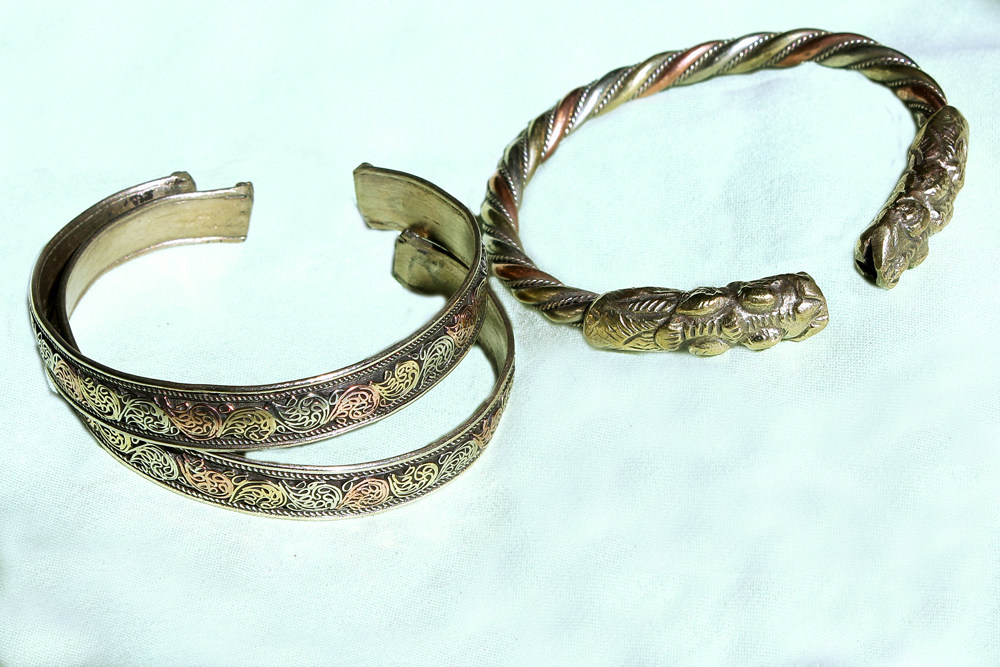
Typical Use
Made by Newar jewelers, a protective bracelet of five metals symbolizing the Five goddesses: gold, silver, copper, brass, iron.
Mha: pujā-manda:

Typical Use
A Maṇḍala used in Mha: Pūjā.
Devā

Typical Use
A set of butter lamps. Lit in front of images before starting a pūjā.
Ta:si Bva

Typical Use
A fruit basket with a long wick, khelu itā, a flower and a garland on the top. Also contains a whole walnut and a flower called gvāy svā, which does not fade. A Ta: si bva: is to given to wish prosperity and unending life, like the walnut and gvāy svā. Family members get these during Mha: Pūjā in Saunti.
Tamū

Typical Use
A multi-layer brass container, styled as a pagoda, to hold different ingredients for pūjā.
Svā: Pusa

Typical Use
A foot-long square piece of brocade serving as a decorative mat on which flowers are placed, usually used to send materials for use in marriage ceremonies or birthday rituals.
Naugraha-Bivaha

Typical Use
Nine different types of seeds and ākhe offered to the planetary gods during the birthday and the Burā/ Buri Jaṃko rituals to avert misfortunes in the future.
Kheṅ Bātā

Typical Use
A brass bowl for duck eggs and dried/roasted fish. Used to offer sagan during a person’s birthday or any auspicious ceremony expressing congratulations and good luck wishes.
Kholā

Typical Use
A small bowl to hold milk or liquor (thon [rice beer] or aylā [distilled spirits]) during the sagan ritual.
Anti

Typical Use
A brass vessel used to pour aylā (distilled spirits).
Dechāpā/ Khāyekorin

Typical Use
A set of vessels used for nya ga swona ritual. Bottom pot holds khaye (yogurt mixture with salt, tumeric powder, fried fenugreek seeds) small plate on top holds cvelā (boiled / mariniated buffalo meat).
Jvālā Nhaykan

Typical Use
Decorative brass (or silver) object, akin to an ancient mirror. Used during esoteric pūjās. (Usually used with the Sinha:mu as a set.)
Tvādeva

Typical Use
A standing lamp with decorations used at both sides of the door or by the stairs in ritual ceremonies of welcome.
Jokota

Typical Use
Trays used to take pūjā items to the brides’ home before the grooms’ family goes to her home to fetch her; and to accompany the bride on her first return home after marriage.
Dvālya

Typical Use
A set of auspicious items, placed by the door / entrance to welcome chief guests during major rituals, such as the first entrance of the bride into the groom’s house.
Thayebhu

Typical Use
This is an extra large plate (bhu) utilized when a ceremonial meal containing 84 different types of food on rice; Used for auspicious events like first rice feeding, marriage, and Burā / Buri Jaṃko.
Mas

Typical Use
This is a stand for Thayebhu.
Kayenbhu

Typical Use
The usual plate used for lunch, dinner in households. It is offered as a gift to vajrācāryas after a ritual involving the Ratna maṇḍala.
Sijabhu

Typical Use
A copper plate used for pūjā.
Bakunda

Typical Use
A set of bowls used to make two offerings: one for bau (cooked rice) and the other as a recepticle for the oil used to mark out a maṇḍala on the floor for rituals during Saunti (Nep. Tihar).
Yomu Dristi

Typical Use
This is an ornament given as a “third eye” to initiates during the esoteric Dekha ceremony; it is also given to elders during the Burā / Buri Jaṃko saṃskāra.
Donca

Typical Use
A container made of stitched leaves, made to hold cooked rice offerings.
Pañcapatā

Typical Use
Flags of five colors, made of cloth stuck to wooden stick; inserted in a donca; name derived from pañca-pratāpa means “five flags”.
Donca with pañcha patā

Typical Use
Containers for cooked rice offerings, with pañca patā and mostly for decoration.
Homa pūjā Tools

Typical Use
This is the setup used for Homa pūjā, arranged above the fire. The tools include the yamkhāsi (below), ghee, and other supports.
yamkhāsi

Typical Use
A brass pot with a small hole that holds ghee for the homa rituals. Attached to three chains that are fixed on a tripod, it drips the ghee to keep the fire going.
Homa ladles

Typical Use
A set of three ritual tools used for gathering and casting into the fire the ghee and grain offerings. From top to bottom: the sulupā, the dhava, and the catvā.
Wooden Vajra and Ghaṇṭa
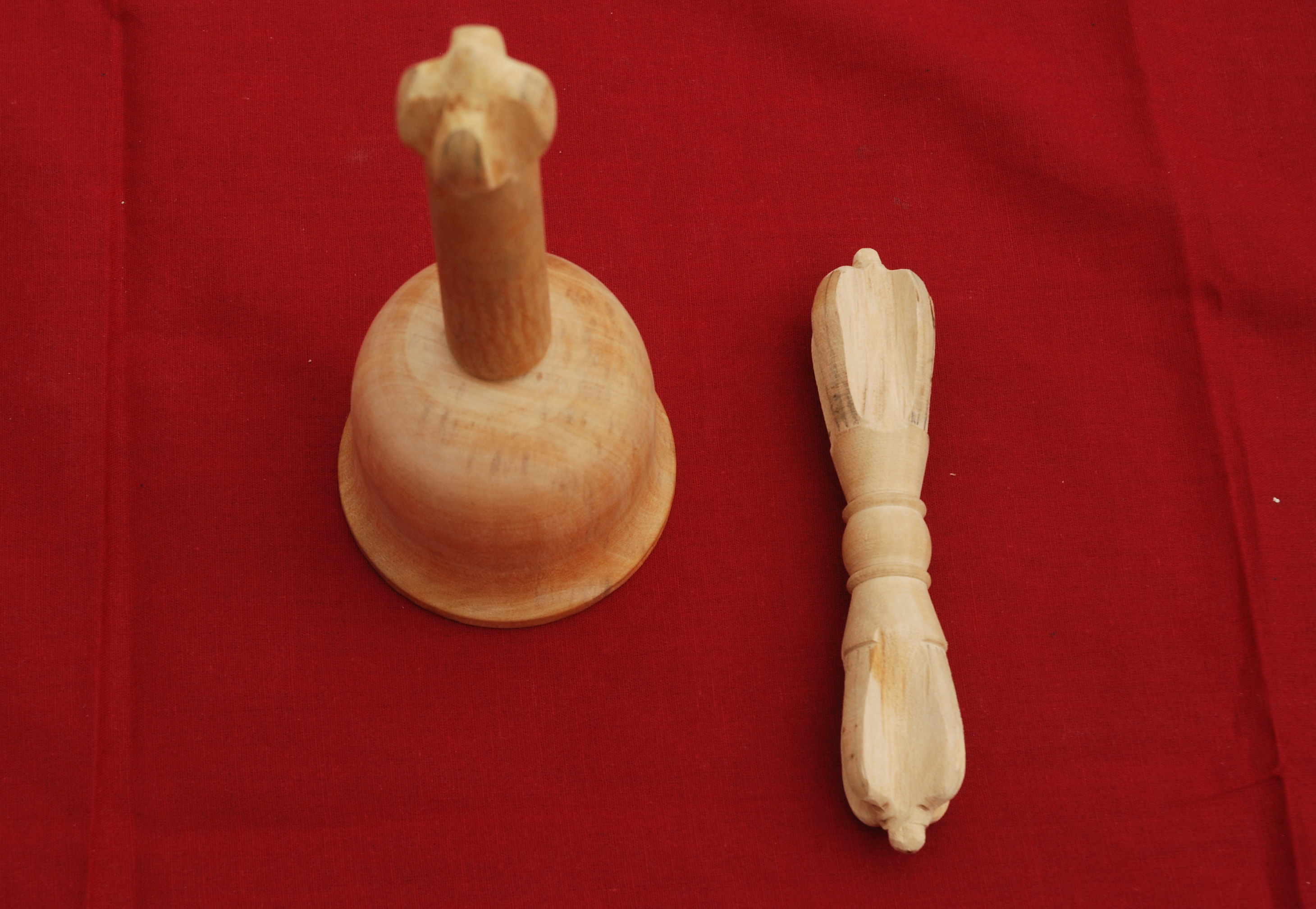
Typical Use
Vajracaryas use these for the last rites at the ghat; due to the death pollution from proximity to the corpse, the regular essential ritual tools made of metal are not used; these are burned in the fire after the rites are completed.
Wooden Homa Tools
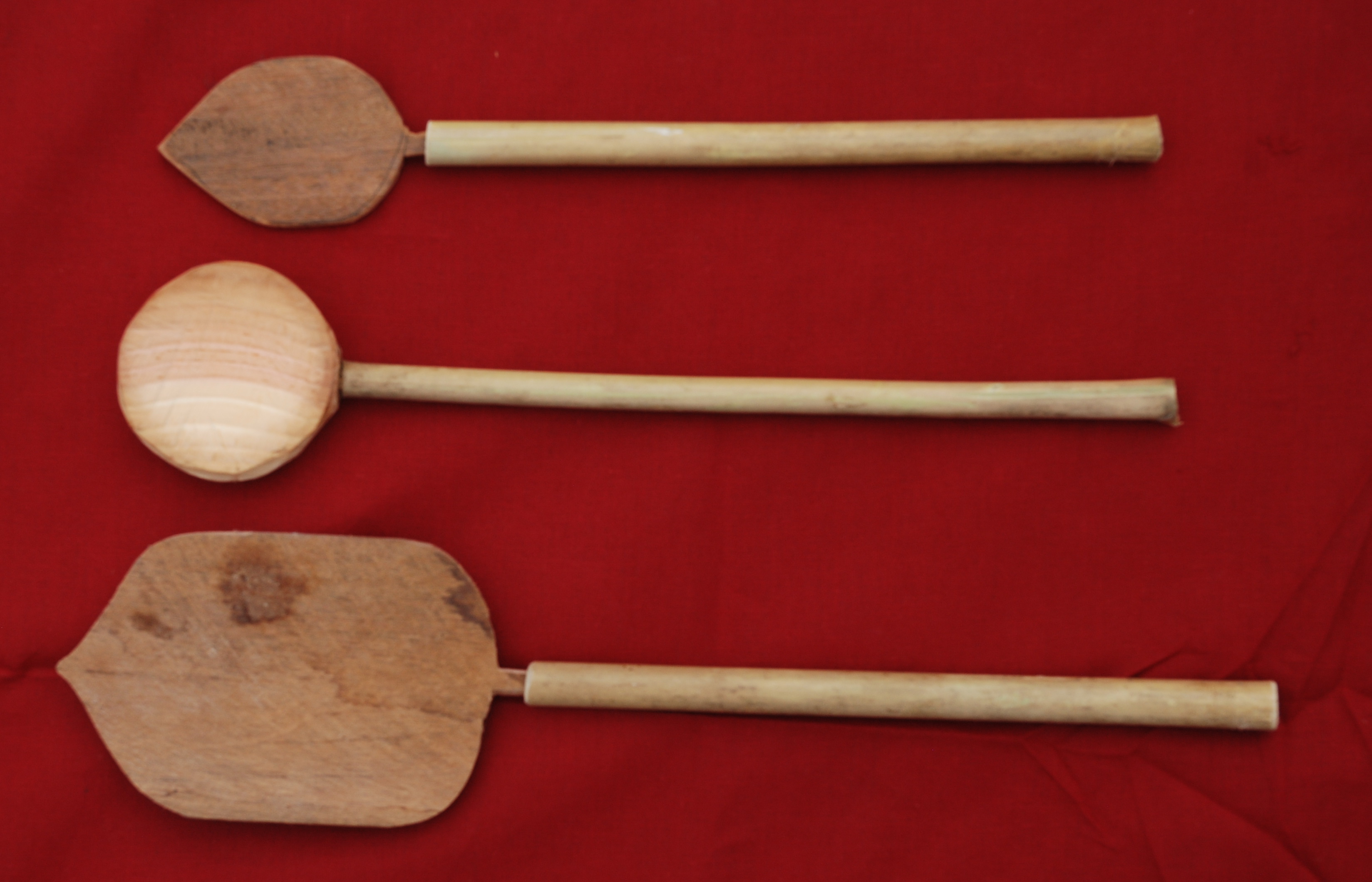
Typical Use
Vajracaryas use these for the last rites at the ghat; due to the death pollution from proximity to the corpse, the regular essential ritual tools made of metal are not used; these are burned in the fire after the rites are completed.
Naivadya-thala

Typical Use
A container for beaten rice and other ingredients such as ghee, honey, and brown sugar on top. Used for the deities who do not take meat offerings.
Maitā and baitā

Typical Use
A set of special wicks. Made from white cotton, Maita is designed to be the length of a human face; the baitā is shorter.
Pañca-rangi Itā jajankā

Typical Use
This is a set of jajankā with five colors, according to the Pañca Buddhas. Prepared in bundles numbering 108, these are soaked in ghee and put them in the fire during the Buddhist homa ritual.
Kalaśa: bīja

Typical Use
Raised stand for special kalaśa ritual.
Karna patā

Typical Use
Rectangular shaped flag colored to match deity; part of an offering to an image, put above the ear.
Purṇā Kalaśa

Typical Use
An important vessel for every auspicious pūjā, especially rituals establishing images and for marriages.
Ināye kalaśa

Typical Use
An importat vessel for every auspicious pūjā to Ganesh, done at the start; used in rituals establishing new images, in saṃskāras such as Burā / Buri Jaṃko.
Nāga kalaśa

Typical Use
A vase painted for auspicious pūjās offered to the nāgas, “serpent deities”.
Yakṣa-yakṣanikalaśa

Typical Use
A set of four kalaśas, each with different contents: raw paddy, husked rice, flower, symbolic blood (khayo). Used for pacification rites for male and female demons.
Aṣṣtamaṅgala

Typical Use
A set of eight auspicious objects with the phaygam bell (below) are a ritual unit. Can be joined in a long string of many sets to surround a ritual site during the largest rituals, especially a new house opening.
Phay gam

Typical Use
“Wind bell”, symbolic of sending out blessings, as does a bell’s sounding.
Kathupvacā
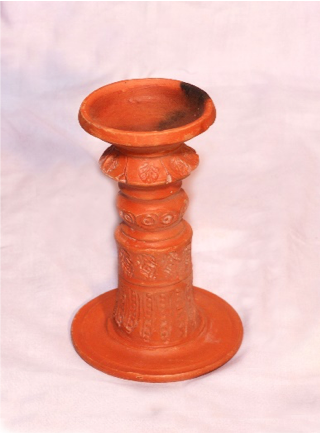
Typical Use
This is the lamp once used before the sukundā came into common use. Most vajrācārya ritualists prefer to use this style of lamp that lacks an image of Ganesh.
Dristi

Typical Use
An eye adornment used only for the deities. They are placed above and between the eyes.
Innaya Kalaśa Chatra

Typical Use
A ritual umbrella placed into a kalaśa offered to elicit blessings from Ganesh.
Gana Kalaśa Chatra

Typical Use
Ritual umbrella used for multiple deities invoked to smaller kalaśa vessels.
Chatra for Purna Kalaśa

Typical Use
Red ritual umbrella placed in the Purna Kalaśa.
Gojā
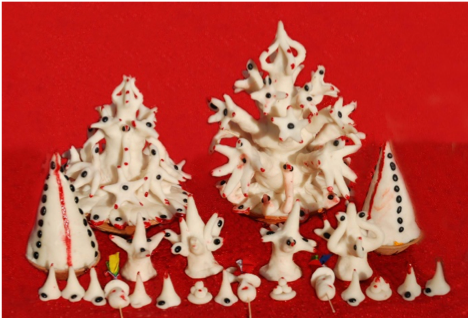

Typical Use
Uniquely Newar rice flour dough offerings, the smallest is also used to accept incense sticks during rituals. The larger forms are used in a sattvo pūjā.
Graha rakṣa-mālā
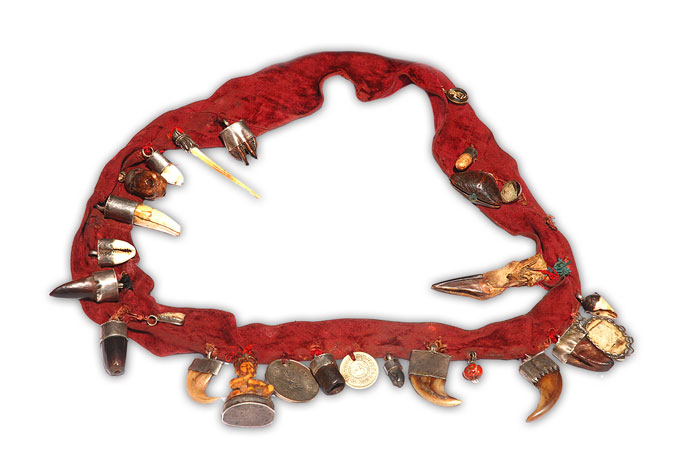
Typical Use
A special necklace, with a collection of precious stones, animal teeth, herbs, etc. that provides protection from planetary deities and other spirits. One can be made and worn by anyone. If given for the first rice feeding rite to a baby (Macā Janko), it is called “Janko tīsa.”
Moki
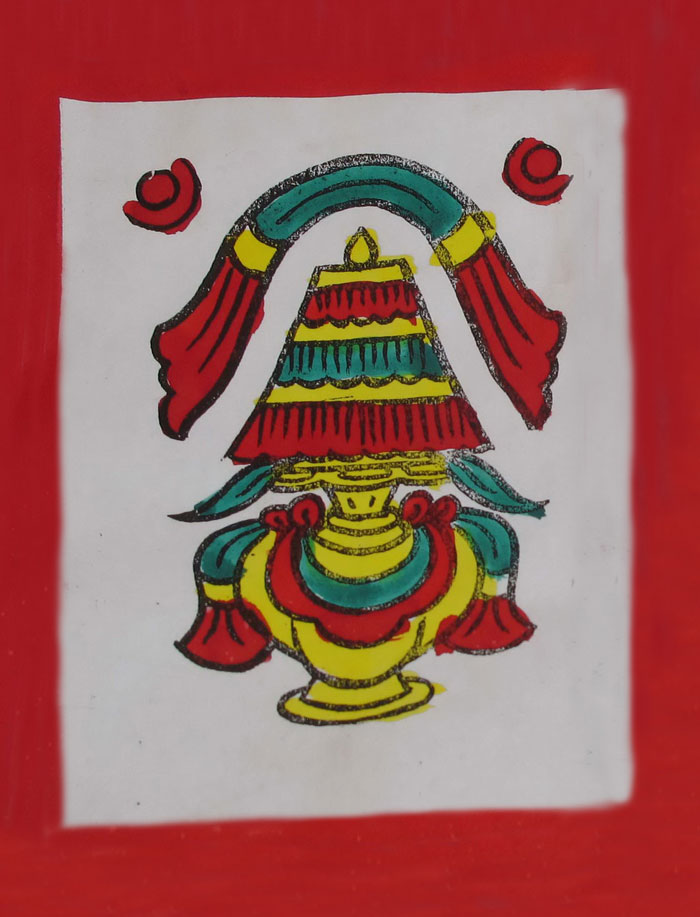
Typical Use
A painting that represents the aṣṭa maṅgala (eight auspicious symbols), prominently showing a purna kalasha. It symbolizes here eight bodhisattvas. On the second day of the Ihi ritual marriage, the girls have this on their heads during the main ceremony, symbolizing that they are vessels for bodhicitta.
Nakin
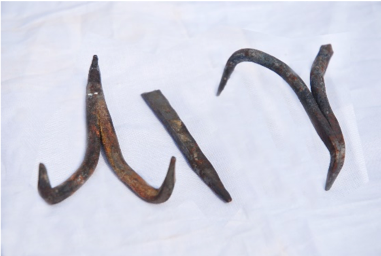
Typical Use
Special iron nails used to rejuvenate protective amulets of house; added yearly to main door lintels during the Gantha Muga festival; used to attach protective yantras during home purification rites.
Jantra
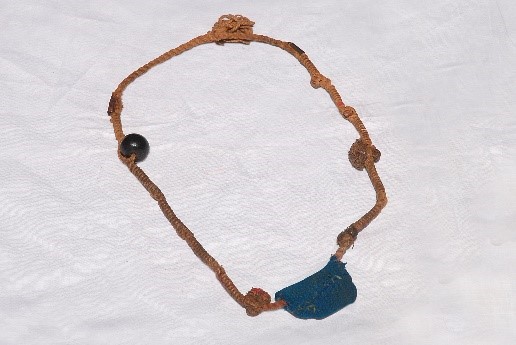
Typical Use
A necklace made of simple thread in which there is a cloth packet attached; it contains a mantra or other protective symbols.
Mundri
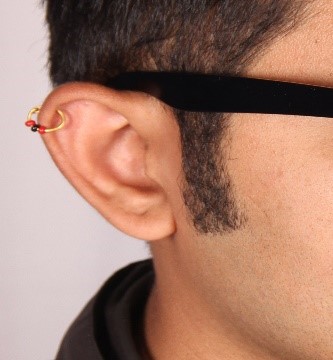
Typical Use
This is a special ornament worn by male or female in only one ear to ensure his / her life. This is especially given to a child who is born alive after many deaths of babies in the family or to a couple.
Sankha and mas
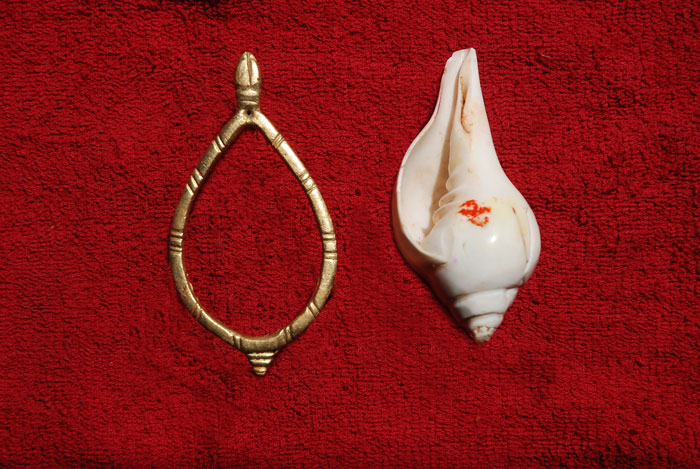
Typical Use
The conch shell with stand is used by priests and householders to make offerings of pure water to sacred objects.
Nāga pūjā
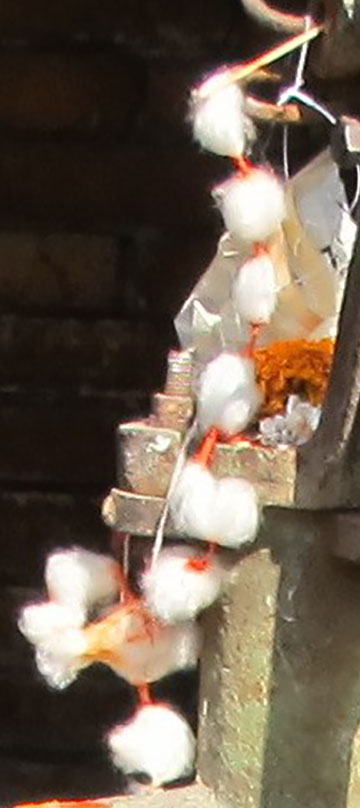
Typical Use
Twisted cotton garland hung vertically to worship nāgas at wells and other sites.
Dalucā
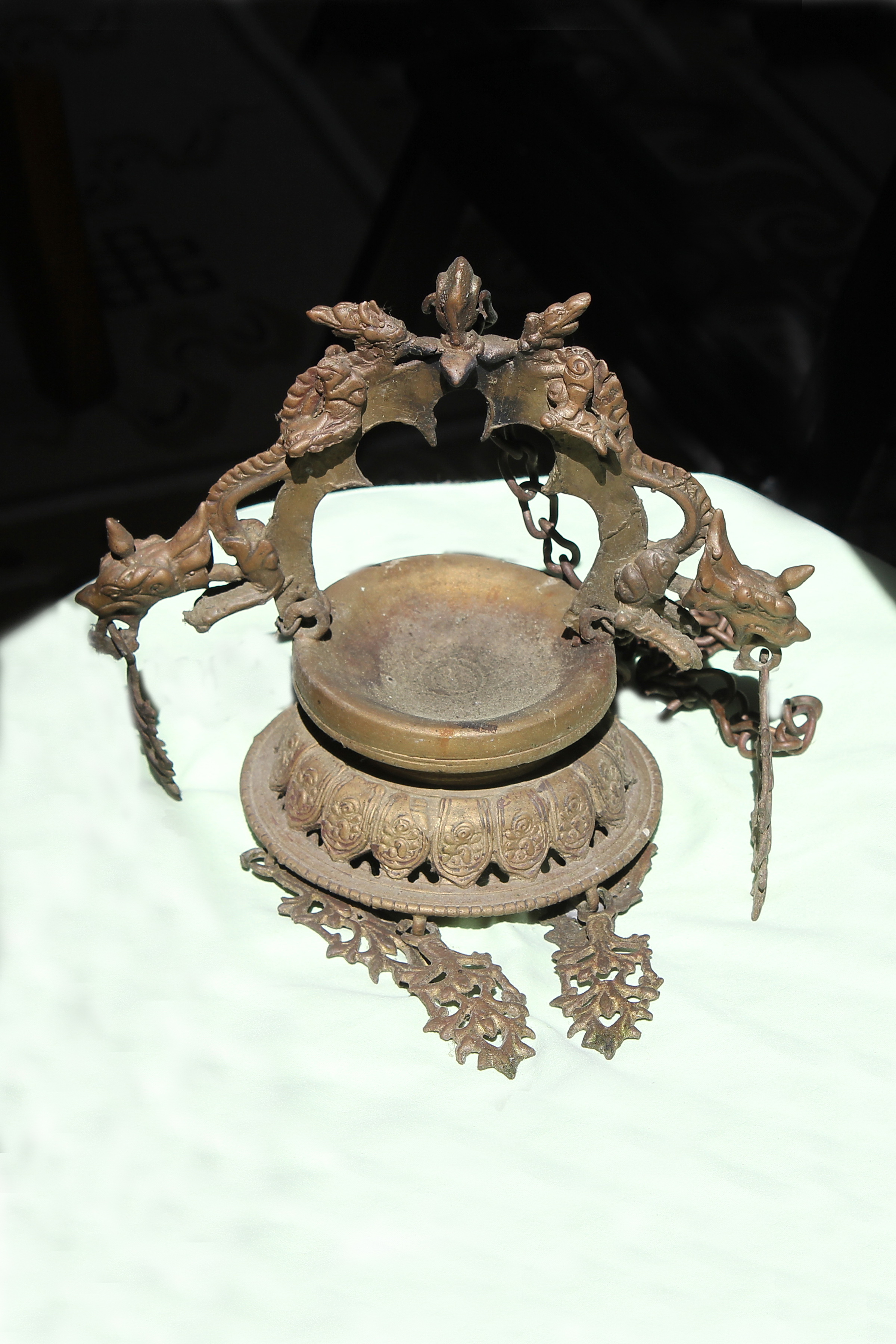
Typical Use
This is a wick lamp that is hung outside an upper-storey window of the home on the day of mourning when the family observes the light-giving ceremony, 12 days after death.
Yak tail fan
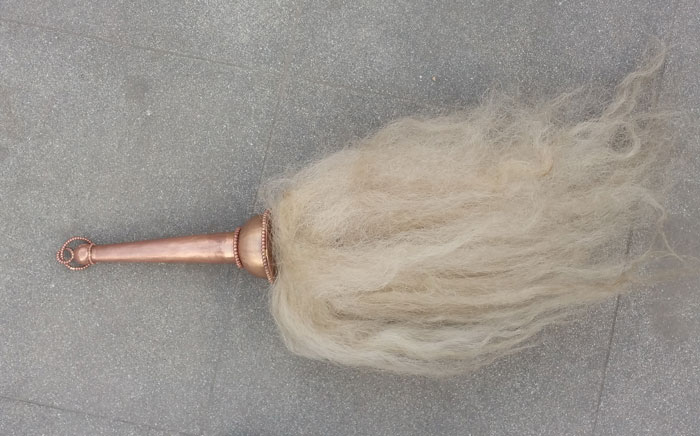
Typical Use
Object used to do ritual fanning of especially sacred images. This fan is still commonly used by Vajrācārya and Śākya ritualists in bāhās when doing the daily rites (nitya pūjā-s) and when images or incarnations of goddesses (such as the kumāris) are pulled on chariots during festivals.
